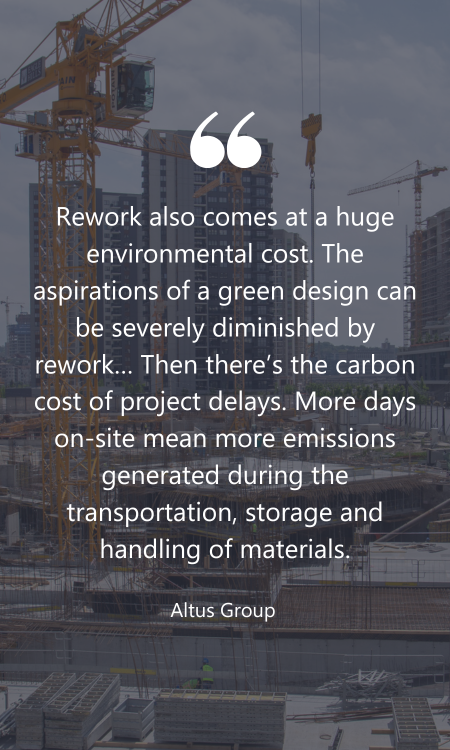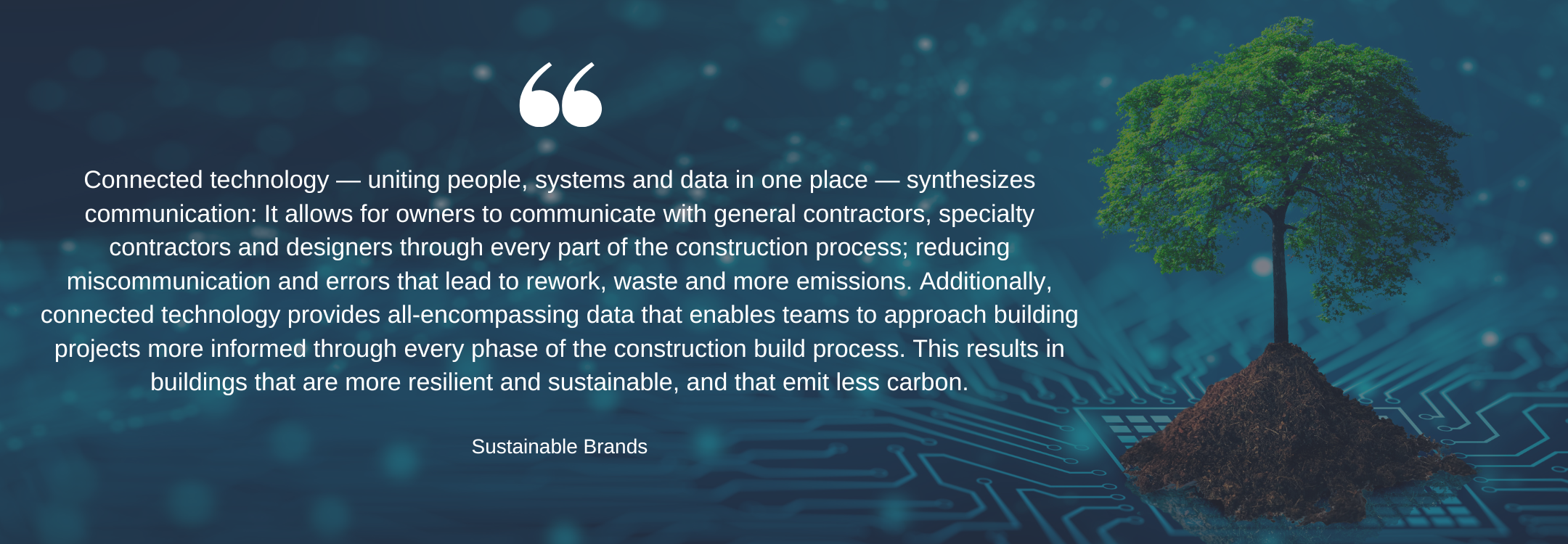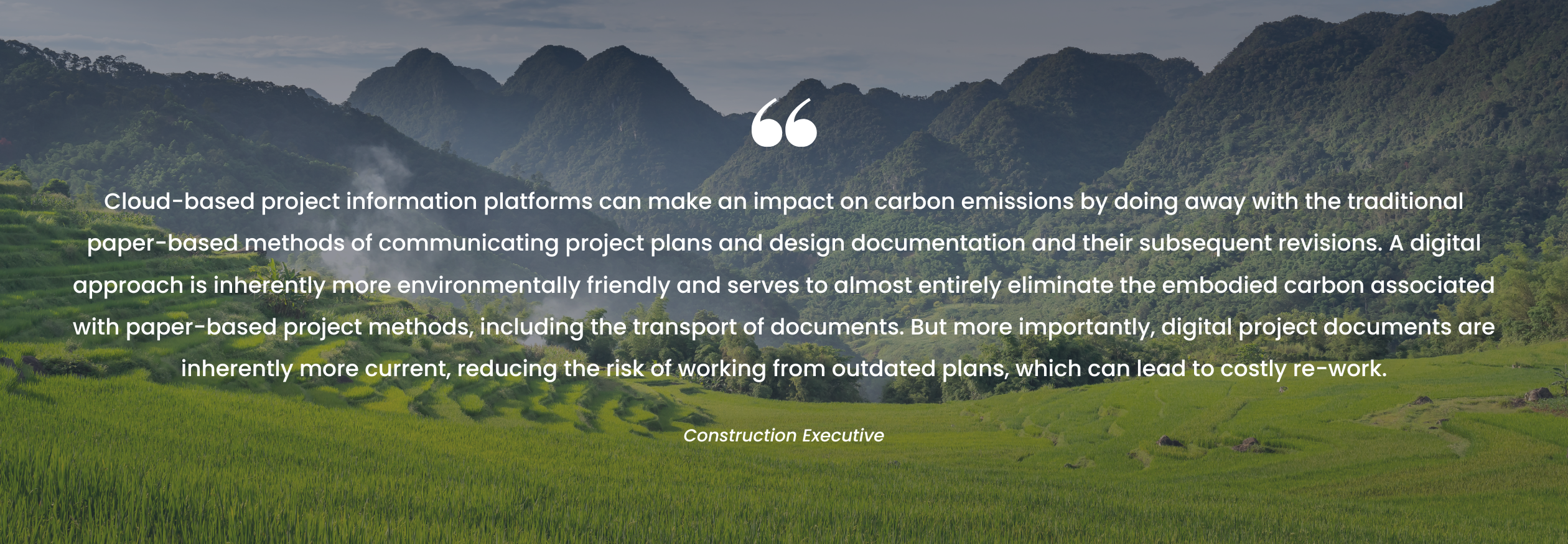
Reduce Your Carbon Emissions When You Reduce Rework
 Today’s construction industry produces more than 40 percent of the world’s carbon emissions, much of which stems from inefficient processes that often result in a significant amount of rework. If this trend persists and nothing is done to address the industry’s systemic inefficiencies, according to the United Nations Environment Programme’s 2022 Global Status Report For Buildings And Construction, by the year 2050 the amount of carbon emissions attributed to the construction industry will rise to 50 percent. Immediate measures must be taken to reverse this trend. The adoption of solutions that have been proven to improve accuracy, promote collaboration, and emphasize transparency across entire project teams are already available and can deliver excellent results in the quest to eliminate rework and, ultimately, greatly reduce carbon emissions.
Today’s construction industry produces more than 40 percent of the world’s carbon emissions, much of which stems from inefficient processes that often result in a significant amount of rework. If this trend persists and nothing is done to address the industry’s systemic inefficiencies, according to the United Nations Environment Programme’s 2022 Global Status Report For Buildings And Construction, by the year 2050 the amount of carbon emissions attributed to the construction industry will rise to 50 percent. Immediate measures must be taken to reverse this trend. The adoption of solutions that have been proven to improve accuracy, promote collaboration, and emphasize transparency across entire project teams are already available and can deliver excellent results in the quest to eliminate rework and, ultimately, greatly reduce carbon emissions.
The Impact Of Rework On Carbon Emissions
Studies that point to the correlation between carbon emissions and rework are readily available. Researchers in Australia, for example, found a direct correlation between rework (five percent of a project’s total cost) and carbon emissions (responsible for a five percent increase of carbon emissions on a project.). Another study, produced by researchers at the University of California, Berkeley, estimated that rework adds between 3-10 percent to the embodied carbon, or the greenhouse gas (GHG) emissions associated with designing, constructing, maintaining, and decommissioning buildings on a project.
Fortunately, the likelihood of rework can be significantly reduced and, in some cases, eliminated simply by introducing and using tools that:
- Result in greater collaboration across project teams for the purpose of addressing issues before problems arise at the project site.
- Improve the accuracy of data and information at the earliest phases of the project.
- Facilitate trust and accountability across the project team, the information produced by team members, and the project leadership’s ability to provide oversight.
Addressing collaboration, accuracy, and trust on a project is an easy and effective way to stop the likelihood of rework in its tracks, which will likely result in an immediate reduction of the carbon emissions attributed to construction costs.
How To Reduce Construction’s Collective Carbon Footprint
While the AEC (architecture, engineering, and construction) industry has traditionally been slower in its digital transformation journey, there has been some momentum in recent years to reduce the number of information silos on a project, particularly with the introduction of CDEs (common data environments). Unfortunately, due to the complexity of the built world, different CDEs tend to appeal to different subsegments of the AEC, resulting in “super silos.” For example, those in the construction segment, tend to use Procore as their CDE, while designers prefer to use Autodesk. Because these different platforms fail to fully integrate to each other, the lack of collaboration, accuracy, and trust persists, and instances of rework have not subsided.
Rather than introducing yet another silo, ProjectReady went another way. Rather than introducing another CDE, the ProjectReady team set to work to create the AEC’s first-ever fully cloud-based IDE (integrated data environment). An IDE goes beyond the traditional siloed framework and applies process over the platforms in play – effectively bridging the gaps that exist between the tech solutions in today’s marketplace. This approach has been essential to true facilitation of collaboration, improved accuracy, and the reinforcement trust and accountability across project teams.
Rework is the result of inefficiency, and inefficiency is rooted in an inability to collaborate across stakeholders on information in a way that’s consistent for everyone on a project. By integrating the silos that currently exist to allow stakeholders to collaborate on project information – regardless of where the project information originated – has been a key driver in ProjectReady’s work to improve efficiencies, reduce rework and, ultimately, reduce the industry’s disproportionate carbon footprint.
ProjectReady is working to reduce the construction industry’s carbon footprint in three major areas:
1. Facilitate Trust
First and foremost, project team members must be able to trust that the information they are working with is accurate, appropriately stored, and all changes made to a document or design are tracked. Furthermore, project stakeholders must trust that only certain roles on the project should have access to certain content. ProjectReady not only delivers the ability to uniquely track all transactional data that flows through the system, but the solution also deploys automation to apply roles-based security and governance over project information. These processes are also responsible for establishing the governance necessary to:
- Sync content across platforms instantly and on a schedule.
- Bridge critical document control workflows between Procore and Autodesk.
- Establish, monitor, and manage information to keep the project moving forward and on schedule.
By applying process over the platforms in play on a project, the team can rest assured knowing that only the right people have access to the right information. Project teams can now operate knowing that they are, indeed, working from a single source of truth (SSOT), that all information is accurate and current, and information is appropriately governed across systems.
Read Also: Wondering If You Can Trust That App?
2. Eliminate Errors
According to the Get It Right Initiative (GIRI), eliminating errors across all phases of construction could save on embodied carbon within resources used on a project as well as emissions related to transportation and other construction-related emissions. Setting up the project in ProjectReady can be done in five minutes or less and serves to provide the foundation upon which collaboration can take place, errors can be eliminated, and rework can be reduced.
ProjectReady also addresses the industry’s need to eliminate errors by giving users access to a unique set of tools that ultimately reduce the likelihood of human error, which is reflected in the reduction of carbon emissions. These tools include:
- Repeatable standards
- Document generation
- Flexible project management
- Instant reporting
- Connected workflows
- Document synchronization
3. Improve Collaboration
Collaboration is critical to drive effective communication, coordination, and enhance project understanding. As a cloud-based IDE designed to facilitate collaboration across stakeholders by removing silos around critical project information and allowing governed access to a single source of truth, ProjectReady’s emphasis on collaboration at the heart of the solution. When architects, engineers, contractors, and building owners have the tools to collaborate on the project in real time, there are fewer disputes, issues can be addressed quickly and before they become problems, and the entire team is on the same page when it comes to what needs to be accomplished and by when. By building critical collaboration tools into the platform, ProjectReady makes it easier than ever to for teams to work together – regardless of the platform in play (i.e. Autodesk, Procore, PlanGrid, etc.).
The following integrations and tools facilitate collaboration with ProjectReady:
- Outlook integration
- Microsoft Teams integration
- Bluebeam Studio Sessions integration
- Connected Workflows – the ability to add notes and feedback at each stage
Furthermore, because collaboration that occurs in ProjectReady is governed, all records of conversations, feedback, remarks, etc., are logged and can be referenced at any time during the project – or long after project closeout.
Read Also: What Is CPIM? Project Information Management That Prioritizes Collaboration
ProjectReady For Carbon Emission Reduction
ProjectReady provides a much-needed solution in the quest to reduce carbon emissions within the AEC industry. As the first and only true IDE in the market today, the solution greatly reduces the need for physical meetings, provides a platform for the governed sharing of data, and facilitates communication between different teams, reducing the likelihood of errors, duplicate work and, therefore, energy consumption. Furthermore, as a fully cloud-based solution, ProjectReady addresses the universal global emissions challenge by providing a platform for stakeholders to share, work together, and collaborate on project data and information (including design files, schedules, budgets, and performance metrics) in real-time, from anywhere in the world while helping the construction industry reduce its carbon footprint.
Learn more
Want to learn more about ProjectReady and how an IDE can help your organization reach its carbon emissions goals? Click on the button below to reach out to a ProjectReady professional today.


